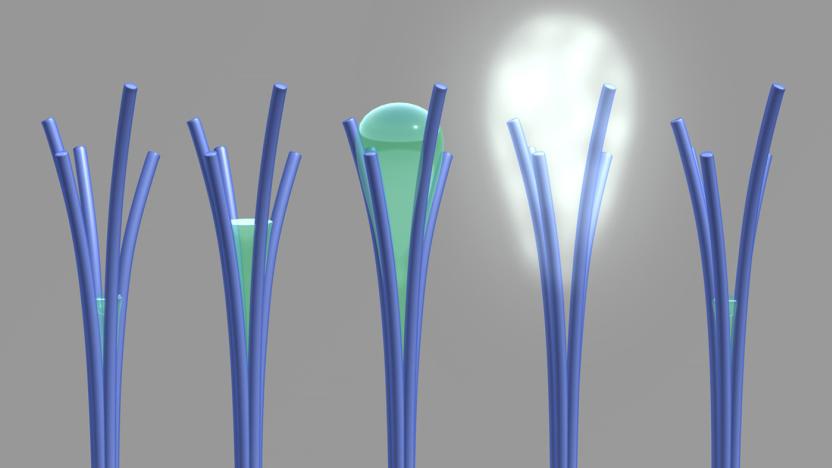nanorod
Latest

Nanorods could harvest water in dry climates
Sometimes it's the accidental discoveries that make the biggest impact. Researchers at Pacific Northwest National Laboratory have learned that carbon-rich nanorods created in a botched experiment might be ideal for harvesting water. When there's relatively low humidity (below 50 percent), the rods trap water inside their gaps; if it's any more humid, however, they promptly expel that water as vapor. It's a very unusual trait that's likely caused by water condensing into a "bridge" in the nanorods, whose surface tension forces them to close and eventually kick the water out.

MIT's genetically modified viruses boost solar-cell efficiency by herding nanotubes
The wizards of MIT have done it again. Having checked artificial leaves and Operabots off the to-do list, they've moved on to improving the efficiency of solar cells. Their technique combines a genetically modified version of the M13 virus with carbon nanotubes, which have already been shown to increase efficiency. Unfortunately, some nanotubes enhance solar cell performance, while others inhibit it – and both types tend to clump together, negating their benefits. The modified M13 virus, however, can separate the two types as well as prevent clumping; we've seen similar use of the Tobacco mosaic virus to build better electrodes. Adding virus-built structures to dye-sensitized solar cells increased power conversion efficiency by almost one-third and, with only one additional step in the manufacturing process required, the new approach could be rapidly taken up by existing production facilities. MIT: proving once again that viruses are good for more than just smiting your enemies.

World's smallest battery uses a single nanowire, plant-eating virus could improve Li-ion cells tenfold
When it comes to building better batteries, building electrodes with greater surface area is key, and scientists are looking to exotic methods to attract the tiny particles they need. We've already seen graphene and carbon nanotubes soak up those electrons, but the University of Maryland has another idea -- they're using the Tobacco mosaic virus (TMV) to generate usable patterns of nanorods on the surface of existing metal electrodes. By simply modifying the germ and letting it do its thing, then coating the surface with a conductive film, they're generating ten times the energy capacity of a standard lithium-ion battery while simultaneously rendering the nasty vegetarian bug inert. Meanwhile, the Center for Integrated Nanotechnologies (CINT) at Sandia Labs was more curious how these tiny charges actually work without confusing the forest for the trees, so to speak, so a team of scientists set about constructing the world's smallest battery. Using a single tin dioxide nanowire as anode, a chunk of lithium cobalt dioxide as cathode, and piping some liquid electrolyte in between, they took a microscopic video of the charging process. See it in all its grey, goopy glory right after the break.

Physicists create tiny ruler to easily measure nanoscale contraptions
How do you measure items constructed on a nanoscale assembly line? Why, using a plasmon ruler that measures how much the structure's surrounding gas resonates, of course... and it just so happens that science has theoretically built a better one than ever before. Researchers at China's Wuhan University discovered that by using nanospheres "to modify surface plasmon coupling of a nanorod dimer" -- yes, that's a little over our heads, too -- they could create a linear plasmon ruler that allows one to read how far apart the particles are using a far simpler calculation and modify the range of measurement more easily too. None of this may seem important to you at the moment, but remember: nobody wants imprecisely-sized nanites crawling through their tubes.

